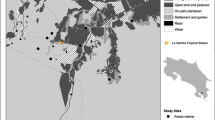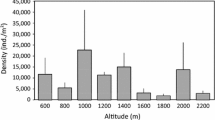Abstract
Invasive African olive, Olea europaea ssp. cuspidata (Wall. ex G.Don) Cif., forms increasingly dense stands between initial and mature stages of invasion, leading to a progressive decline in native plant diversity. Here, we examined the response of leaf-litter invertebrates to increasing time since olive invasion. We compared invertebrate assemblages among early-stage olive (0–7 years since invasion, scattered olive shrubs and seedlings in native woodland), mature olive (>15 years, uniform olive stands dominated by multi-trunked trees) and uninvaded native grassy woodland habitats (both mature stands and edges) in a critically endangered ecological community of south-eastern Australia. Invertebrate species richness was significantly reduced in mature olive compared with early-stage olive and mature native woodland habitats. Species richness did not differ significantly between early-stage olive habitat and mature native woodland, demonstrating resistance in species richness to initial invasion. Invertebrate species composition of native woodlands differed significantly from both mature olive and early-stage olive habitats, demonstrating a lack of resistance in species composition to initial olive invasion. Compositional differences were principally driven by reduced abundances within Coleoptera, Hymenoptera and Polyxenida in mature olive habitat compared with mature native woodland. These changes were significantly correlated with an increase in bare ground, plant canopy cover and litter depth, and higher moisture and lower temperature within leaf litter, in mature olive habitat. Our findings show that negative ecological impacts of invasive African olive extend beyond plants to leaf-litter invertebrate assemblages and that significant impacts on invertebrate species assemblage composition occur early in the invasion process.





Similar content being viewed by others
References
Abell AJ (1999) Variation in clutch size and offspring size relative to environmental conditions in the lizard Sceloporus virgatus. J Herpetol 33:173–180
Adair RJ, Groves RH (1998) Impact of environmental weeds on biodiversity. NPWS, Canberra
Baker AC, Murray BR (2010) Relationships between leaf-litter traits and the emergence and early growth of invasive Pinus radiata seedlings. Weed Res 50:586–596
Barton PS, Manning AD, Gibb H, Lindenmayer DB, Cunningham SA (2010) Fine-scale heterogeneity in beetle assemblages under co-occurring Eucalyptus in the same subgenus. J Biogeogr 37:1927–1937
Bates D, Maechler M, Bolker B, Walker S (2014) lme4: linear mixed-effects models using eigen and S4. R package version 1.1-7. http://CRAN.R-project.org/package=lme4
Bernays E, Graham M (1988) On the evolution of host specificity in phytophagous arthropods. Ecology 69:886–892
Bock CE, Bock JH, Jepson KL, Ortega JC (1986) Ecological effects of planting African lovegrasses in Arizona. Natl Geogr Res 2:456–463
Braithwaite RW (1991) Fauna and habitat surveys as ecological pathfinders. In: Margules CR, Austin MP (eds) Nature conservation: cost effective conservation: cost effective biological surveys and data analysis. CSIRO, Australia, pp 23–28
Braithwaite RW, Miller L, Wood JT (1988) The ecological structure of termites in the Australian tropics. Aust J Ecol 13:379–391
Burke DM, Nol E (1998) Influence of food abundance, nest site habitat, and forest fragmentation on breeding oven-birds. Auk 115:96–104
Clarke C, Lake PS, O’Dowd DJ (2004) Ecological impacts on aquatic macroinvertebrates following upland stream invasion by a ponded pasture grass (Glyceria maxima) in southern Australia. Mar Freshw Res 55:709–713
Collinge SK, Prudic KL, Oliver JC (2003) Effects of local habitat characteristics and landscape context on grassland butterfly diversity. Conserv Biol 17:178–187
Colwell RK (2013) EstimateS: statistical estimation of species richness and shared species from samples. Version 9.1.0 User’s guide and application published at http://viceroy.eeb.uconn.edu/
Colwell RK, Mao CX, Chang J (2004) Interpolating, extrapolating, and comparing incidence-based species accumulation curves. Ecology 85:2717–2727
Crisp PN, Dickinson JM, Gibbs GW (1998) Does native invertebrate diversity reflect native plant diversity? A case study from New Zealand and implications for conservation. Biol Conserv 2:209–220
CSIRO (1991) The insects of Australia: a textbook for students and research workers, 2nd edn. Melbourne University Press, Victoria
Cuneo P, Leishman MR (2006) African Olive (Olea europaea subsp. cuspidata) as an environmental weed in eastern Australia: a review. Cunninghamia 9:545–577
Cuneo P, Leishman MR (2013) Ecological impacts of invasive African olive (Olea europaea ssp. cuspidata) in Cumberland Plain Woodland, Sydney, Australia. Austral Ecol 38:103–110
Dennis P, Young MR, Gordon IJ (1998) Distribution and abundance of small insects and arachnids in relation to structural heterogeneity of grazed indigenous grasslands. Ecol Entomol 23:253–264
Ehrenfeld JG (2003) Effects of exotic plant invasions on soil cycling processes. Ecosystems 6:503–523
Ernst C, Cappuccino N (2005) The effects of an invasive alien vine, Vincetoxicum rossicum (Asclepiadaceae), on arthropod populations in Ontario old fields. Biol Invasions 7:417–425
Finch OD (2005) Evaluation of mature conifer plantations as secondary habitat for epigeic forest arthropods (Coleoptera: Carabidae; Araneae). For Ecol Manag 204:21–34
Fox GA, Negrete-Yankelevich S, Sosa VJ (2015) Ecological statistics: contemporary theory and application. Oxford University Press, Oxford
Frost SW (1959) Insect life and insect natural history, 2nd edn. Dover Publications, New York
Gerber E, Krebs C, Murrell C, Moretti M, Rocklin R, Schaffner U (2008) Exotic invasive knotweeds (Fallopia spp.) negatively affect native plant and invertebrate assemblages in European riparian habitats. Biol Conserv 141:646–654
Gotelli NJ, Colwell RK (2001) Quantifying biodiversity: procedures and pitfalls in the measurement and comparison of species richness. Ecol Lett 4:379–391
Haddad NM, Tilman D, Haarstad J, Ritchie M, Knops JMH (2001) Contrasting effects of plant richness and composition on insect communities: a field experiment. Am Nat 158:17–35
Hadden SA, Westbroke ME (1996) Habitat relationships of the herpetofauna of remnant buloke woodlands of the Wimmera Plains, Victoria. Wildl Res 23:363–372
Harrison F (2011) Getting started with meta-analysis. Methods Ecol Evol 2:1–10
Harvey MS, Yen AL (1989) Worms to wasps: an illustrated guide to Australia’s terrestrial invertebrates. Oxford University Press, Melbourne
Hassan RA (2000) Diversity in the decomposing landscape. In: Coleman DC, Hendrix PF (eds) Invertebrates as webmasters in ecosystems. CABI Publishing, Wallingford, pp 203–219
Hättenschwiler S, Tiunov AV, Scheu S (2005) Biodiversity and litter decomposition in terrestrial ecosystems. Annu Rev Ecol Evol S 36:191–218
Hejda M, Pyšek P, Jarošík V (2009) Impact of invasive plants on the species richness, diversity and composition of invaded communities. J Ecol 97:393–403
Legendre P, Legendre L (2012) Numerical Ecology, 3rd edn. Elsevier, Amsterdam
Lenth R (2015) lsmeans: least-squares means. R package version 2.21-1. https://CRAN.R-project.org/package=lsmeans
Levine JM, Vila M, D’Antonio CM, Dukes JS, Grigulis Lavorel S (2003) Mechanisms underlying the impacts of exotic plant invasions. Proc R Soc Lond B Biol 270:775–781
Lindsay EA, French K (2006) The impact of the weed Chrysanthemoides monilifera ssp. rotundata on coastal leaf litter invertebrates. Biol Invasions 8:177–192
Martin LJ, Murray BR (2011) A predictive framework and review of the ecological impacts of exotic plant invasions on reptiles and amphibians. Biol Rev 86:407–419
Mazzotti FJ, Ostrenko W, Smith AT (1981) Effects of the exotic plants Melaleuca quinquenervia and Casuarina equisetifolia on small mammal population in the eastern Florida Everglades. Fla Sci 44:65–71
Millennium Ecosystem Assessment (2005) Ecosystems and human well-being: biodiversity synthesis. World Resources Institute, Washington
Moeed A, Meeds MJ (1985) Seasonality of pit-fall trapped invertebrates in three types of native forest. NZ J Zool 12:17–53
Murray BR, Phillips ML (2012) Invasiveness in exotic plant species is linked to high seed survival in the soil. Evol Ecol Res 14:83–94
Murray BR, Dickman CR, Robson T, Haythornthwaite A, Cantlay AJ, Dowsett N, Hills N (2007) Effects of exotic plants in native vegetation on species richness and abundance of birds and mammals. In: Lunney D, Eby P, Hutchings P, Burgin S (eds) Pest or guest: the zoology of overabundance. Royal Zoological Society of New South Wales, Mosman, pp 216–221
Murray BR, Baker AC, Robson TC (2009) Impacts of the replacement of native woodland with exotic pine plantations on leaf-litter invertebrate assemblages: a test of a novel framework. Int J Ecol. doi:10.1155/2009/490395
Oksanen J, Blanchet FG, Kindt R, Legendre P, Minchin PR, O’Hara RB, Simpson GL, Solymos P, Henry M, Stevens H, Wagner H (2015) vegan: community ecology package. R package version 2.3-0. https://CRAN.R-project.org/package=vegan
Oliver I, Beattie AJ (1993) A possible method for the rapid assessment of biodiversity. Conserv Biol 7:562–568
Oliver I, Beattie AJ (1996) Invertebrate morphospecies as surrogates for species: a case study. Conserv Biol 10:99–109
Oliver I, MacNally R, York A (2000) Identifying performance indicators of the effect of forest management on ground-active arthropod diversity using hierarchical partitioning and partial canonical correspondence analysis. For Ecol Manag 139:21–40
Paulson GS (2005) Handbook to the construction and use of insect collection and rearing devices. A guide for teachers with suggested classroom applications. Springer, New York
Potts SG, Woodcock BA, Roberts SPM, Tscheulin T, Pilgrim ES, Brown VK, Tallowin JR (2009) Enhancing pollinator diversity in intensive grasslands. J Appl Ecol 46:369–379
Quinn G, Keough M (2004) Experimental design and data analysis for biologists. Cambridge University Press, Cambridge
R Core Team (2015) R: A language and environment for statistical computing. R Foundation for Statistical Computing, Vienna, Austria. https://www.R-project.org/
Ricciardi A (2007) Are modern biological invasions an unprecedented form of global change? Conserv Biol 21:329–336
Robson TC, Baker AC, Murray BR (2009) Differences in leaf-litter invertebrate assemblages between radiata pine plantations and neighbouring native eucalypt woodland. Austral Ecol 34:368–376
Simberloff D, Vitule JRS (2014) A call for an end to calls for the end of invasion biology. Oikos 123:408–413
Simpson GL (2014) permute: functions for generating restricted permutations of data. R package version 0.8-3. https://CRAN.R-project.org/package=permute
Singh JS, Gupta SR (1977) Plant decomposition and soil respiration in terrestrial ecosystems. Bot Rev 43:449–528
Slobodchikoff CN, Doyen JT (1977) Effects of Ammophila arenaria on sand dune arthropod communities. Ecology 58:1171–1175
Southwood TRE, Henderson PA (2000) Ecological methods. Blackwell Science, Oxford
Southwood TRE, Moran VC, Kennedy CEJ (1982) The assessment of arboreal insect fauna: comparisons of knockdown sampling and faunal lists. Ecol Entomol 7:331–340
Springett JA (1976) Effect of prescribed burning on soil fauna and on litter decomposition in Western Australian Forests. Aust J Ecol 1:77–82
Standish RJ (2004) Impact of an invasive clonal herb on epigaeic invertebrates in forest remnants in New Zealand. Biol Conserv 116:49–58
Standish RJ, Williams PA, Robertson AW, Scott NA, Hedderley DI (2004) Invasion by a perennial herb increases decomposition rate and alters nutrient availability in warm temperate lowland forest remnants. Biol Invasions 6:71–81
Strayer DL (2012) Eight questions about invasions and ecosystem functioning. Ecol Lett 15:1199–1210
Strayer DL, Eviner VT, Jeschke JM, Pace ML (2006) Understanding the long-term effects of species invasions. Trends Ecol Evol 21:645–651
Strong DR, Lawton JH, Southwood R (1984) Insect on plants: community patterns and mechanisms. Harvard University Press, Cambridge
Sutherland WJ (2006) Ecological census techniques: a handbook. Cambridge University Press, Cambridge
Tallamy DW (2004) Do alien plants reduce insect biomass? Conserv Biol 18:1689–1692
Tozer M (2003) The native vegetation of the Cumberland Plain, western Sydney: systematic classification and field identification of communities. Cunninghamia 8:1–75
Valentine LE (2006) Habitat avoidance of an introduced weed by native lizards. Austral Ecol 31:732–735
van Hengstum T, Hooftman DAP, Oostermeijer JGB, van Tienderen PH (2014) Impact of plant invasions on local arthropod communities: a meta-analysis. J Ecol 102:4–11
Vilà M, Espinar JL, Hejda M, Hulme PE, Jarošík V, Maron JL, Pergl J, Schaffner U, Sun Y, Pyšek P (2011) Ecological impacts of invasive alien plants: a meta-analysis of their effects on species, communities and ecosystems. Ecol Lett 14:702–708
Vitousek PM (1990) Biological invasions and ecosystem processes—towards integration of population biology and ecosystem studies. Oikos 57:7–13
Vitousek PM, Walker LP (1989) Biological invasions by Myrica faya in Hawaii: plant demography, nitrogen fixation and ecosystem effects. Ecol Monogr 59:247–265
Weis AE, Berenbaum MR (1989) Herbivorous insects and green plants. In: Abrahamson WA (ed) Plant–animal interactions. McGraw-Hill, New York, pp 123–162
Acknowledgments
We thank the UTS technical staff in environmental sciences for their assistance. We are grateful to Amanda Stokes, Tuyen Nguyen, Vong Nguyen, Megan Phillips, Tom Riker and Dan Simberloff.
Author information
Authors and Affiliations
Corresponding author
Rights and permissions
About this article
Cite this article
Nguyen, K.Q., Cuneo, P., Cunningham, S.A. et al. Ecological effects of increasing time since invasion by the exotic African olive (Olea europaea ssp. cuspidata) on leaf-litter invertebrate assemblages. Biol Invasions 18, 1689–1699 (2016). https://doi.org/10.1007/s10530-016-1111-8
Received:
Accepted:
Published:
Issue Date:
DOI: https://doi.org/10.1007/s10530-016-1111-8




